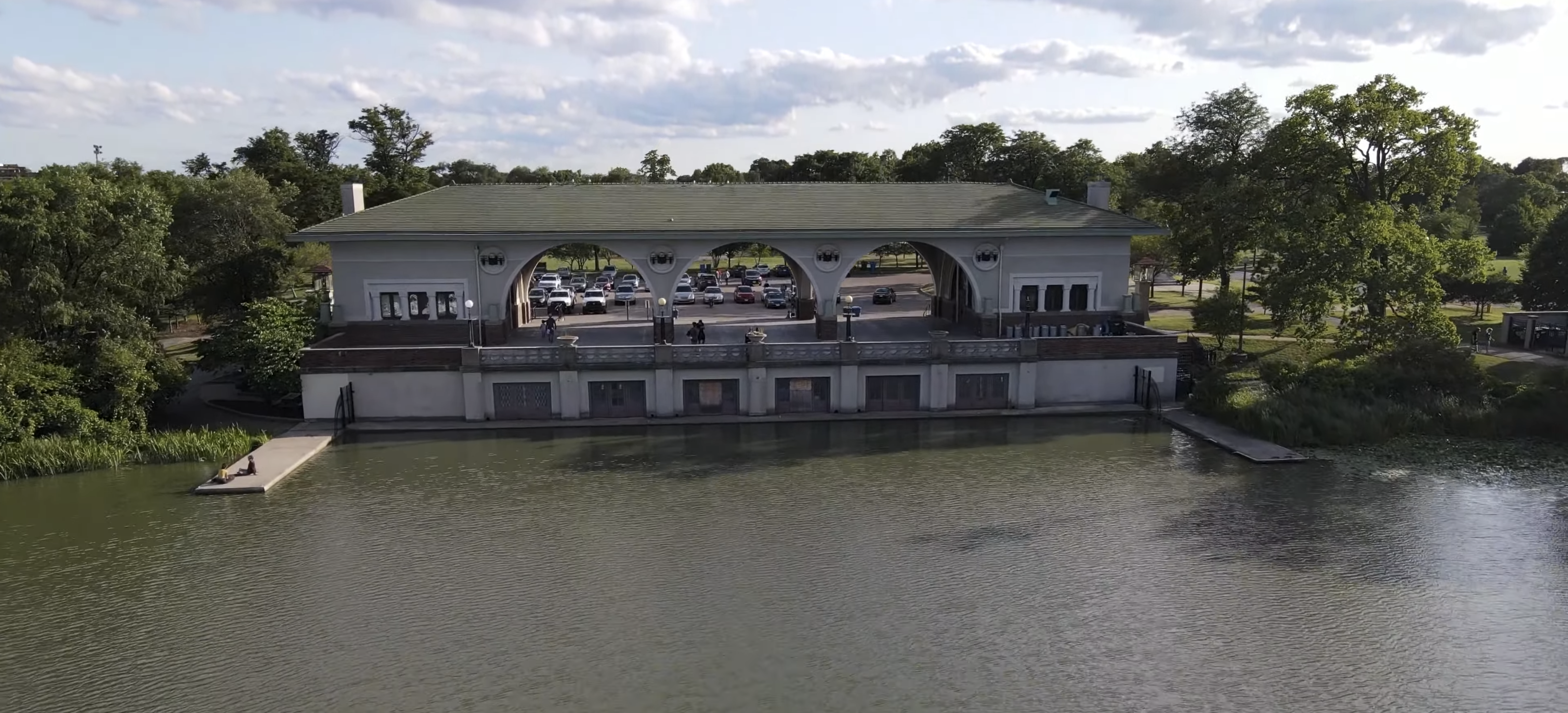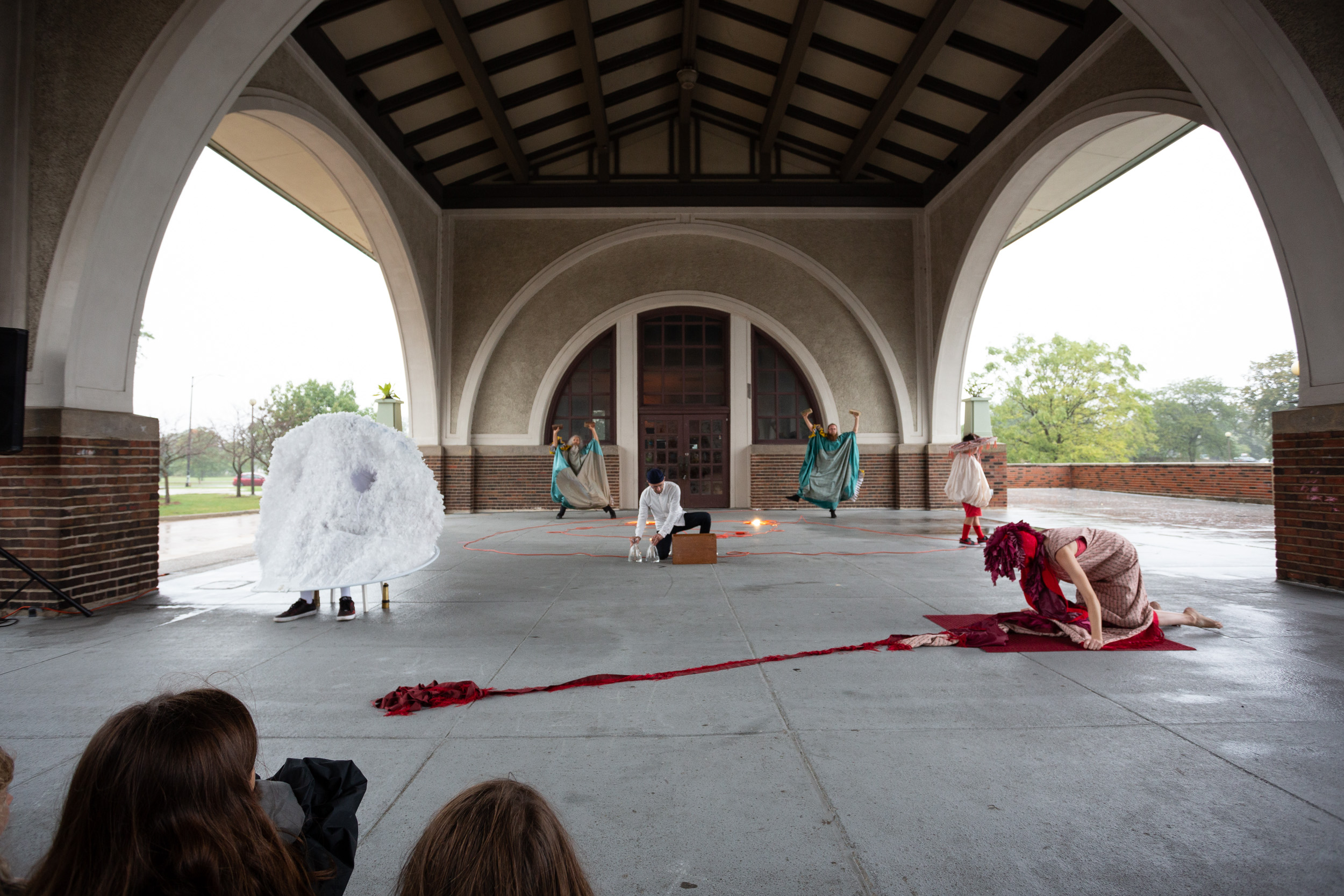A Site of Evanescence
Lin Hixson, A Site of Evanescence, 2022, performance, 50 min, [photo: Joshi Rodin; courtesy of the artist and Every house has a door]
Share:
How do you perform with an endangered fish?
By becoming imperceptible.
How do you become imperceptible?
By finding the point of fusion between yourself, as a performer, and the endangered animal you are performing.
The Boathouse
Humboldt Park Boathouse, April 16, 2022, 2pm, Chicago
It began with a boathouse, a rehearsal, and the wind. Performers took their places onstage, under the roof of the Humboldt Park boathouse, in Chicago in mid-April. To begin the rehearsal, the stagehands, on cue, held up costumes and textiles for the performers to dress. The costumes and textiles blew away. The stagehands then placed performance objects on the ground. The objects scattered. The musicians began to play the score. It could not be heard. And the cold air became colder.
The architecture of the boathouse created a wind tunnel. The sweeping air from the sky, descended and blew forcefully through its three concrete arches.
I—the director—stopped the rehearsal. Later that day, I decided to move the performance to a location protected by a wall, near the boathouse but outside of it, and outside of the wind.
There is more to say. But to say it now means getting ahead of myself, and ahead of the story of the performance—(Broken) Aquarium—and its fusion of performer, boathouse, and evanescence.
Humboldt Park Boathouse [courtesy of YouTube]
Aquarium
Aquarium is the title of the seventh movement of Camille Saint-Saëns’ 1886 musical composition for children, Carnival of the Animals.
There are fourteen movements in the composition:
Royal March of the Lion
Hens and Roosters
Wild Asses: Swift Animals
Tortoises
The Elephant
Kangaroos
Aquarium
Characters with Long Ears
The Cuckoo in the Depth of the Woods
Aviary
Pianists
Fossils
The Swan
Finale
We, the performance company Every house has a door, and Essi Kausalainen—a textile and visual artist based in Helsinki—are making fourteen performances in response to each of the titles of Saint-Saëns’ movements. In our Carnival of the Animals, all the animals are endangered. Aquarium is the title of the almost-completed performance that we created in 2019–2020. In this performance, each performer performed a fish in peril.
Where did the fish begin and where did it end? we asked.
Kausalainen designed textiles for the performers to wear. She constructed these textiles in response to each performer and the specific creature they played. Kausalainen describes her textiles as a relation, a way of being with. In the particular case of Aquarium, it was being with fish and being with performer. The costumes broke the idea of clothes and instead, they activated body-sites for the performers to wear. Blurring the lines between performer and fish, a tentative relationship emerged between the two. The textiles sculpted an event-fabric, a middle in mobility. The performers set this middle in motion. To do this, they had, in rehearsal, watched videos of how to tread water and combined those gestures with actions modeled on their specific fish.
Each performer used organic and inorganic objects to construct an individual domain on stage, based upon the habitat of their endangered fish. Onions, beets, bricks, extension cords, lightbulbs, a red carpet, a turquoise tarp, and synthetic tassels extended the architectures of the performer-fish as they lifted, threw, or stretched out with the objects. A sound score played to create our imaginary aquarium, circumscribing the edges of the performance area and exerting pressure on the air.
Lin Hixson, A Site of Evanescence, 2022, performance, 50 min, [photo: Joshi Rodin; courtesy of the artist and Every house has a door]
Broken
March 18, 2020
Below is an excerpt from a newsletter of Every house has a door, written by dramaturg, Matthew Goulish, on March 18, 2020.
Dear friends and supporters,
Performance as we know it and as we need it has always had an element of the impossible. That element has become more prominent.
Like many people, we had grand plans a few days ago. We planned to fly to Rijeka, Croatia, in May to continue work on Aquarium, our large-scale performance project in collaboration with Helsinki-based artist Essi Kausalainen. We have nearly completed its composition, in advance of its scheduled premier in November. Now, like so many people, as we wait to learn the future of all our plans, we turn our attention to matters of care, of service in whatever way we can, and of health, physical and mental.
Over the next year and a half, during the Covid-19 pandemic, the live version of Aquarium idled. And around us—
The house rained.
The sky swarmed.
The clouds sparrowed.
The elephants merged back into mud.
A tree ate itself.
A poisoned wave blocked the sun.
The river stopped swimming.
They heard a silent gong.
The cold sardine woke.
Cranes ate smashed plums.
The lion circled outside.
His entrails quarreled.
Birds sprouted dust.
Two detached wings flew.
A hiss in the sky revived her flight.
In the fall of 2021, we applied and were accepted to the city of Chicago’s Night Out in the Parks program to perform Broken Aquarium outdoors at the Humboldt Park Boathouse the following year. We had renamed Aquarium to acknowledge the changes that took place in ourselves and in the world during the past few years. The premier was set for September 11, 2022, at 2pm.
Outside the Boathouse
Humboldt Park Boathouse, Sept. 1, 2022, 2pm, Chicago.
We returned to the Boathouse on Sept. 1, 2022, to begin our rehearsals for the premiere that would be 10 days later. In our new location and in the late summer sun, it was hot. We were outside the shade of the boathouse roof and performing on a concrete surface. The performers and musicians wore hats and sunscreen, but their skin still burned. The performers’ costumes got wet with sweat and slipped when they moved.
I, watching, as an audience member, was in the direct line of the sun and too uncomfortable to concentrate.
We started monitoring the weather, compulsively, with the hopes of a cooler day on Sept. 11. But as we approached the designated date of the performance, another weather pattern intervened. A high probability of rain was predicted. Two days before the premiere, we moved the performance back into its original site and under the boathouse roof. We choose protection from the rain over the possible force of the wind that we experienced the previous April.
Inside the Boathouse
Humboldt Park Boathouse, Sept. 11, 2022, 2pm, Chicago
Broken Aquarium Premiere
From the National Weather Service Sept. 11, 2022
An upper-level low created areas of torrential rainfall that started in northern Illinois during the early morning hours of Sept. 11th and expanded eastward into the Chicago metro. Some of the strongest showers produced tropical rainfall rates on the order of 6 to 8 inches per hour leading to a swath of 2 to 5 inches of rain falling across parts of the Chicago metro causing flooding of several roads and basements on the north side of Chicago. The flooding in Chicago was the most significant and impacting for the north side of Chicago in at least two years.
The phone rang early on Sept. 11. Some of our performers had flooding in their apartments. The musicians were concerned about their equipment getting wet. Others were not sure they could drive through the water to get to the boathouse.
I consulted with our technical director and company manager. Both quoted weather and sailing apps from their phones.
Two o’clock showed a clearing of the storm. We decided to perform.
Five Sites of Evanescence
How do you perform with a boathouse built in 1907?
By becoming imperceptible.
How do you become imperceptible?
By finding the point of fusion between yourself as a performer and the cosmos.
What is this point?
A site of evanescence.
Hour after hour the boathouse waited, watching us. It dreamed up its own ideas and mingled with wind, sky, and earth to blow frigid air through its arches or heat up its floor to sweltering temperatures. It had its hours of the day and its seasons of the year. It had the wisdom of age. This site was not an empty basin where we entered and then performed. It was an unfixed force—movement that was not reducible to me, the performers, or the performance. We had no choice but to co-compose with it and participate in its wonder.
What follows are four co-compositions from Broken Aquarium:
The performers enter. They walk to their places with the blowing rain. Making a half circle around them on one side, approximately 200 people watch. The sky holds so much water that those on the perimeters get wet. Some open umbrellas. A performer lifts her hand the way the wind lifts a leaf, and water unites the moment.
The rain is like an animal shaking itself against the soundtrack. Chord riffs and ethereal electronics collide with the insistent drone of water falling. They talk together like silver knives.
Our youngest performer, 11 years old, walks to the place where he performs a Fibonacci pattern, tracing a path based on a fractal. He hesitates. There is a large puddle in his way. He steps forward, directly into it, submerging his sneaker in water and dreaming his way into the puddle.
A flock of geese, honking, travels south over the boathouse as the performance ends. Time stops. I know that time cannot stand still. But there are times when time slips into other times, and it feels like it’s holding its breath and me with it. It is here, in this moment, that Broken Aquarium goes aerial and travels forward with the flock.
This text is part of ART PAPERS Summer 2024 theme, Interpreting Site, is guest edited by Sherae Rimpsey, the inaugural Mildred Thompson Arts Writing + Editorial Fellow.
Lin Hixson co-founded Every house has a door in 2008, the Chicago-based performance company that she directs. She was director of the performance group Goat Island (1987–2009). Every house has a door has presented both nationallyand internationally including Prague, Helsinki, Glasgow, London, New York, Austin, and Chicago. She has received awards from the United States Artists, Foundation for Contemporary Arts, The Driehaus Foundation, Chicago Dancemakers Forum, and the National Endowment for the Arts. Residencies have included The Bellagio Center, MANCC, and the Rauschenberg Foundation. Her writing has been published in the journals Poetry, Performance Research, and Parallax, as well as the anthologies The Creative Critic– Writing as/about Practice and The Twenty-First Century Performance Reader. She is Professor Emerita of Performance at The School of the Art Institute of Chicago and holds an Honorary Doctorate from Dartington College of Arts.

